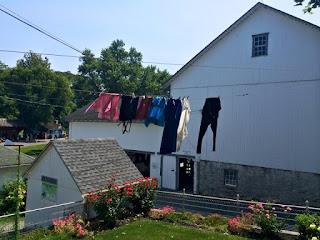The Amish Way of Living
The Daily Star link
Date of publication: Sept. 9, 2015
I first came across the word, Amish, in one of the volumes of Nancy Drew mystery stories series some 20 odd years ago. At that time, I knew nothing about the Amish and who they are. As I became older I read about them on the Internet at various times; I even watched several episodes of a reality TV show called “Breaking Amish” a couple of years ago. In short, the Amish and their lifestyle had intrigued me and I always wanted to see first-hand what the life of these simple people is like.
Date of publication: Sept. 9, 2015
I first came across the word, Amish, in one of the volumes of Nancy Drew mystery stories series some 20 odd years ago. At that time, I knew nothing about the Amish and who they are. As I became older I read about them on the Internet at various times; I even watched several episodes of a reality TV show called “Breaking Amish” a couple of years ago. In short, the Amish and their lifestyle had intrigued me and I always wanted to see first-hand what the life of these simple people is like.
The Lancaster County of Pennsylvania is home to some 30,000 Amish people; it’s a major tourist destination for those who want to experience the Amish way of living. Pennsylvania is also the oldest Amish settlement in America. The Amish are a group of Anabaptist Christians, who believe in the baptism of adults, not infants. Amish, who confess their faith, are baptized again as adults -- the word ‘ana’ means, again. An Amish, who transgresses, is excommunicated, which means that an Amish person who violates Amish practices is shunned from the community.
The Amish came to the United States in the mid 1700s to flee religious persecution in Europe. They are a people who believe in simple living, wear plain clothing, and reject many of the conveniences of modern technology. It may be hard to believe but English is actually the Amish's second language! Their first language is German, which is also known as Pennsylvania German.
During our trip to the Lancaster county in August, we visited The Amish Village, where one gets to see an authentic Amish farmhouse built in 1840, an Amish schoolhouse, a barn with animals, a blacksmith shop, Amish buggy, plow, etc. The price of a tour varies from $9.25 to $26 per person.
The Amish do not use electricity at home or in their farm. While they do not think electricity is evil, they believe that electricity will bring into Amish homes the conveniences of modern world and distract people. Family is the most important part in the life of an Amish man or woman and they believe the modern-day conveniences will distract a person’s attention from his or her family. Face-to-face communication is very important in the Amish community.
We learned from our tour that instead of electricity, they use alternative sources like batteries, solar panels, windmills, gas, kerosene and compressed air to power their appliances. Our tour guide, Justin, showed us a gas-powered iron and washing machine, a propane gas-powered refrigerator and lamp, and a blender powered by compressed air. The Amish use gas stoves for cooking, while some homes still use the old wood cook stoves. They do not own automobiles, and use community phones only for emergencies and business purposes. All of this may sound completely unbelievable but this is how the Amish live in this 21st century!
The Amish, who believe in the universal values of modesty and humility, wear hand-made plain clothing. Amish clothing is made from solid-coloured fabric, no patterns or prints at all. Only black, white and muted colours are allowed. Amish homes typically do not have closets so clothes are kept on wall hooks. An Amish person may have as few as three sets of clothing. The woman never cut their hair and wear kapps (caps) to cover their hair -- black for unmarried women and white for married women.
Amish women wear simple cape dress and apron -- the dress does not have buttons and is kept in place using straight pins. I watched in amazement as our tour guide showed us an Amish dress and apron and how they were fastened using small, sharp, straight pins. Pins are used in women’s clothing because women change their size much more often than men because of pregnancy. The pins therefore allow them to make size adjustments without making a whole new set of clothes.
Amish men stop shaving their beards after marriage, they wear hats and suspenders instead of belts. All Amish garments look alike -- they believe that wearing fashionable clothing or clothing with ornaments may give a person an inflated sense of pride. This is also the reason why they do not pose before a camera, check themselves in the mirror (unless one has to shave beard or fix one’s hair), or wear make-up.
While driving our car through the scenic country roads of Lancaster, we saw Amish men and women in Amish buggies. Here, horse-drawn carriages and automobiles share the narrow country roads. An automobile driver often has to slow down and follow a carriage until it makes a turn.
We had a relaxing three hours in the Lancaster County. Hills and green vegetation, country roads, buggies and people in plain clothing carried us to a different world, a world that makes you feel that a simple life can sometimes be so much better the action-packed, technology-dependent life that we lead in the English world (that’s what the Amish call the world outside their own).
I remember our tour guide saying at one point, “From my experience of living alongside the Amish, I can say that they are actually much happier than people like us, who live with all the conveniences of modern day."




Comments